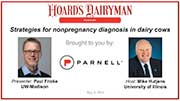
While we all like to hear that a cow is confirmed pregnant, there also is value in knowing that she is not. At that point, she can be quickly placed on a reproductive protocol to prepare for the next insemination, and hopefully produce a pregnancy.
Paul Fricke, University of Wisconsin-Madison, presented the monthly Hoard's Dairyman webinar "Strategies for nonpregnancy diagnosis in dairy cows."
For confirming a pregnancy, you have several options. The "hands-on" choices include ultrasound evaluation after 30 days, rectal palpation after 35 days, or the old-timer's "calf bumping" at six to seven months. Obviously the first two are preferred as results are more immediate and reliable.
While there is some debate as to when is the right time to pregnancy check via ultrasound, Fricke suggests day 30. The reason? There is a growth spurt for the embryo between day 25 and day 32, which allows the technician to be more confident in his or her diagnosis of a viable embryo with a larger conceptus.
There are also blood and milk tests to determine pregnancy. Pregnant cows produce more than 20 specific proteins. Commercial companies have developed tests to identify these pregnancy-associated glycoproteins (PAGs) and therefore can determine pregnancy status if the PAG they have isolated is present. However, once a cow calves, she continues to have PAGs in her blood for up to 60 days postcalving, which can cause a false reading. Some of these tests can be performed on the dairy, while others involve shipping a sample to a lab for evaluation.
Some pregnancy tests can be done through monthly DHI milk testing, but weekly screening would be more desirable to find nonpregnant cows sooner.
While 21 days between heats is commonplace, 35 percent of cows have an extended luteal phase where they may not show visual heats. We may be falsely led to believe the cow is pregnant without estrus activity 21 days after insemination. However, the extended time is attributed to the cow undergoing an early pregnancy loss.
If pregnancy is confirmed at day 32, Fricke recommends a retest at 74 days because there is a point at around 70 days, before which false readings are more likely due to early embryonic death losses.
Costs are comparable for palpation, ultrasound, blood test and milk test, ranging from $2 to $5, depending on number of samples, number of cows checked and local lab options.
The webinar was sponsored by Parnell and can be viewed here.

The author is the online media manager and is responsible for the website, webinars and social media. A graduate of Modesto Junior College and Fresno State, she was raised on a California dairy and frequently blogs on youth programs and consumer issues.








